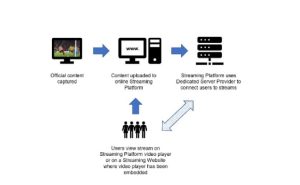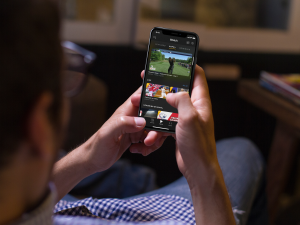- Slug: Sports-Illegal Sports Streaming, 2,600 words.
- 2 photos available. (thumbnails, captions below)
- Graphic available.
By Jordy Fee-Platt and Hayden Cilley
Cronkite News
PHOENIX – In recent years, the live sports landscape has shifted dramatically. Cable subscriptions are declining and streaming services are dominating television screens across the country.
Nearly 80% of sports fans have watched sports on any streaming or online channel this year, according to Nielsen. While streaming providers like Amazon Prime have landed lucrative deals and others like Netflix are looking to get in on the craze, there is a lesser-discussed side to the streaming age.
With technology advancing, illegal streaming has risen in popularity, giving those with an internet connection access to live sports for free. For those unable or unwilling to pay for subscriptions, these streaming websites allow them to keep in touch with their favorite teams or desired games. College students make up a large portion of the frequent visitors, as people ages 18-29 make up 28% of those who pirated media through online streaming. With some no longer able to rely on cable at home and with limited budgets, they are forced to resort to unconventional avenues.
“These leagues know they have a monopoly over the viewing content,” said 24-year-old Jackson Wald, a frequent consumer of illegal streaming sites. “Like if you want to watch RedZone, you have to go through NFL. So they can charge whatever you want. There are student discounts, but when you’re a college kid, you’re not trying to spend $150, when there’s a free, mostly good alternative.”
As a 2022 Kenyon College graduate, Wald has watched live sports on these illegal streams since his freshman year in 2018. He watched as peers around him were frequent users of these services and sought to watch games they wouldn’t have access to outside of local markets. Students would gather together for NFL Sundays, all through the power of an illegal stream.
Frequent streamer and 23-year-old Joe Wint uses the websites to stay on top of all of his favorite Boston sports teams. The Kenyon College graduate fears it might jeopardize a crucial tie to his family if he were to lose access.
“I typically prefer it over the national broadcasts, listening to the personalities I grew up with,” Wint said. “And obviously when the games are not nationally televised, there’s no hindrance to watching the game and catching up with your friends and family about it back home. It’s something I bond over with my family, so making it harder to access those games would be really tough.”
Students often lament the difficulty of tuning into a favorite sports team while living in a different state. Arizona State students from Los Angeles, for example, who are accustomed to watching the Los Angeles Dodgers locally on the Spectrum Television network suddenly don’t have access to their favorite team.
Unfortunately for Wint, Wald and millions of others, illegal streaming may no longer be an option in the future. In May, the United States Patent and Trademark Office (USPTO) published a notice on efforts to combat “counterfeiting and piracy,” requesting information from the private sector about what it has observed about the phenomenon. The USPTO received written responses from various large companies, including Google and Amazon. They also received responses from four major professional sports leagues: the NFL, the NBA, the NBA and the English Premier League.
The UFC, NFL and NBA collectively sent in a response to the U.S. Office of Policy and International Affairs in August regarding their thoughts on anti-counterfeit and anti-piracy measures that the federal government should take. These businesses highlighted that people can watch their programs and services through various means, including streaming services and apps.
The numbers are staggering for not just these companies, but the global sports industry. The report states that the industry is losing an additional “$28 billion in additional potential annual revenue from sports fans who would be “converting” from pirated content to paid content, even when excluding viewers who are least likely to pay for sports content.”
In 1998, history would change to be in favor of companies like UFC, NFL and the NBA. The Digital Millennium Copyright Act, or better known as DMCA, was signed by former United States president Bill Clinton and protects people from online theft. The law makes it illegal to reproduce another form of content without paying for it.
While national broadcasts provide exposure for teams, lower-end market teams get the short end of the stick and less time under the spotlight.
This isn’t solely a sports business problem. It is a nationwide issue. Across the country, digital video piracy causes lost domestic revenues of at least $29.2 billion and as much as $71.0 billion annually. The use of pirated content creates a domino effect on the United States economy. The frequent use of pirated digital content “results in losses to the U.S. economy of between 230,000 and 560,000 jobs and between $47.5 billion and $115.3 billion in reduced gross domestic product (GDP) each year,” according to the U.S. Chamber of Commerce.
In their responses to the USPTO, the sports businesses argue that a change to the DMCA is necessary. With the advancement of the internet and the introduction of streaming technology, the laws have grown outdated, the document reads. A key stipulation in the DMCA states that violators of copyright must take action “expeditiously to remove, or disable access to” pirated content when requested to do so.
Within a separate response filed to the government, the UFC argues that there is no definition provided for what expeditious removal actually means. Online service providers, or OSPs, take advantage of this vague wording and do not remove streams for hours. If a removal occurs, it doesn’t happen until the game or sporting event has already concluded.
“UFC events last only a few hours—with the most anticipated “bouts” sometimes lasting as little as a matter of minutes, and with the “essence” of each bout (such as a knockout) lasting only seconds,” the UFC writes in their letter. “For this reason, if someone is able to view a pirated version of that content via livestreaming during the event or pirated recordings posted shortly after an event, that tangibly supplants the market for legitimate pay-per-view purchases of that UFC content.”
However, the DMCA did not factor live sports into the equation when it was written. In multiple responses from the sports leagues, a change of the wording is proposed; instead of “expeditious” removal, it should instead be stated as “instantaneous or near-instantaneous” removal. This would put pressure on the OSPs to expedite their takedowns.
The leagues are facing the fact that many streamers are operating from outside the U.S., allowing them to avoid many of the regulations against piracy. Takedown requests from sports leagues are often met with little to no response. The lack of concern from these streamers is likely largely a result of the challenge to formulate lawsuits against “extraterritorial entities.” Unlike other countries, the U.S. does not have a “site-blocking” process, which entails internet providers blocking websites domestically that “are primarily geared at infringing activity.”
Infringed content has been a huge issue ever since the inception of the internet. One of the most notorious websites was “The Pirate Bay.” Founded by Swedish anti-copyright group Piratbyrån in 2003, they prompted “torrenting,” which allowed large files like video games and movies to be downloaded onto a device such as a computer. Piratbyrån faced complaints and backlash from companies claiming that they were stealing the content.
How Piratbyrån slithered around the backlash was saying that they were in accordance with the Swedish anti-piracy laws, not the United States DMCA. They also stated that they didn’t share any files, but rather showed people how to access those files. Torrenting in the U.S. is very much a gray area, unlike the UK, which ruled it as outright illegal, and India, which ruled it “absolutely not illegal.” For context, The House of the Dragon had approximately 17% of the total illegal streams worldwide, according to data from 2022.
Netflix had a little torrenting problem of its own before 2023. Although the company didn’t allow for its content to be infringed, it did allow passwords to be shared between multiple people, thus creating the illusion of infringing content. After Netflix implemented its password-sharing rules, the company added 8.8 million new users, despite the ongoing strike by Hollywood writers and actors.
In its August letter, the UFC proposed extreme measures to implement the site-blocking process. The promotion’s first proposal would be to incorporate “live fingerprinting” technology, which could detect pirated content and automatically block its availability to the consumer, removing the request process which allows streamers to continue their process. The technology could identify repeat offenders while giving copyright owners the power to orchestrate the takedown process themselves.
These potential changes were discussed at a roundtable organized by the USPTO on Oct. 3 in Alexandria, Virginia, where representatives from UFC, the NBA and the NFL spoke on the issue.
Despite the apparent sense of urgency, frequent viewers are unconcerned. They have no reason to believe in the ability of the government and sports leagues to truly crack down.
“I don’t really have any confidence in these leagues to be able to shut this stuff down. I think a Pandora’s box has already been opened,” Wald said. “People are going to find ways to stream stuff illegally. I do it with movies all the time for example. I can imagine it being much more tedious. But things are always going to pop up.”
The leagues argue there are many potential security concerns associated with consuming these off-brand websites, including damaging malware to personal electronic devices and fraud. Younger generations, accustomed to consuming media from a variety of different mediums, are not particularly worried.
“Growing up with technology in a different way than our parents did, I’m used to interacting with more off-kilter sources,” Wint said. “Like watching movies and TV shows off websites, you just become desensitized to risk. There’s risk in it, but there’s also risk in using social media. I don’t have a sense that my data is secure regardless, so it doesn’t add much.”
US-based sports leagues are looking to take inspiration from the English Premier League’s handling of pirated streams in their pursuit of impactful reform. The English Premier League (EPL) has dealt with its fair share of troubles of digital piracy. The EPL submitted a request to the United States Department of Commerce – Patent and Trademark Office in August. The league proposed 14 questions to the U.S., including any challenges the U.S. government is facing and describing any data about the furtherance of online counterfeiting and piracy activity.
The Premier League outlined their prevention strategies, noting that they detected 700,000 “infringing live streams” during the 2022-23 season, and removed 600,000 illegal live streams. They are looking to set the blueprint for the U.S.
“Every minute that an infringing stream is online represents a significant threat to sports rights owners’ economic interests,” the document states.
Much of the illegal streaming does not correlate to people solely wanting to watch games illegally. Their desire comes from a place of curiosity. Many sports fans have found themselves watching more obscure sports and tuning into sports that they normally wouldn’t have before.
“It kind of goes with the changing of the times too … all the younger generation’s media is decentralized,” Wint said. “We bond over having more of the power and agency to see what we want to be seeing. When you meet someone who’s also watching these streams, you know that they’re poking around in games that we typically wouldn’t be able to get. And I think you can be a bigger fan almost by consuming a wide variety of local stations, and more obscure sports.”
The Premier League points out that the promotion of illegal streams takes place on social media, where OSPs can grow the audience of their product. It’s on the “intermediaries” as well to ensure these websites don’t get a platform to share their content. Two illegal streaming strategies are presented, complete with diagrams to highlight how pirated content is broadcasted to the Internet.
The first is open web piracy. It is described as “streams of matches openly available free over the Internet, although generally at reduced quality.” The Premier League gave a diagram below that outlines the four steps before the product reaches the consumer. A pirate must first capture the official broadcast signal, before transferring it from the television via an “HDMI splitter” to a computer. Once on the computer, the pirate uploads the content to a streaming platform, where a link can be created to make it accessible online to the public. That link is shared and can be attached to streaming websites, which consolidates streams into a list of links for consumers to choose from.
An alternative to this formula is “closed network piracy,” where streams are “made available by sophisticated operators, at a generally higher quality, to individuals that have purchased the necessary subscriptions from them, either as a one-off fee or regular subscription.”
The content goes directly to a server once the signal is acquired, giving streamers access to the matches much more quickly. With a fee, they are often getting access to not only one live game but also hundreds of channels of “premium content,” severely limiting a variety of streaming service subscriptions.
“It’s really democratizing sports media,” Wint said. “I think it’s something to consider for all leagues. If you want people around the world to be able to access these games, we can all watch national games, but it’s really not affordable for a lot of people, and if they want to access those smaller communities, they need to significantly reduce the price of these sports packages.”
With the convenience of streaming, people can watch programs whenever they want. Services like YouTube TV are continuing to allow for live streaming, so that people have the live-television functionality of cable. Wald emphasized how although live-streaming services are a good substitute for cable, the way it is being almost monopolized is incentivizing people to stream through alternative methods.
“I think if anything, people might be more inclined to do it,” Wald said. “We have this copious quantity of different sites that you have to pay a lot for that you barely want to use. I don’t want to have to buy Peacock to watch a hockey game. I’m never going to use Peacock, but yet they want 13 dollars a month.
“Streaming was supposed to solve cable, because you bought cable and you had 300 channels, and you watched six of them. So then they said, we’ll put all this stuff on a streaming platform that you want to watch and you won’t have to pay for it. Now all these different corporations, Disney, NBC, HBO, (say), ‘Oh we’re having our own streamers,’ and it just becomes like cable, and it’s really expensive again. So I think having these streaming services is going to make people say, ‘I don’t want to buy all of these, I’d rather just stream it for free online.’”
For more stories from Cronkite News, visit cronkitenews.azpbs.org.


